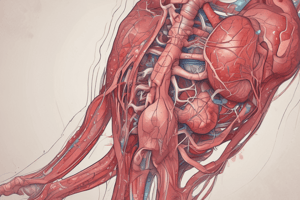Podcast
Questions and Answers
Which of the following is NOT a potential complication of Takayasu disease?
Which of the following is NOT a potential complication of Takayasu disease?
- Kidney failure
- Stroke
- Heart attack
- Diabetes (correct)
Which region has the highest reported prevalence of Takayasu disease?
Which region has the highest reported prevalence of Takayasu disease?
- United States
- India
- China
- Japan (correct)
Which immunosuppressive agent is commonly used in the treatment of Takayasu disease?
Which immunosuppressive agent is commonly used in the treatment of Takayasu disease?
- Methotrexate (correct)
- Prednisone
- Aspirin
- Insulin
What is the typical age range for the onset of Takayasu disease?
What is the typical age range for the onset of Takayasu disease?
Which of the following is NOT a common symptom or presentation of Takayasu disease?
Which of the following is NOT a common symptom or presentation of Takayasu disease?
What is the female-to-male ratio for the incidence of Takayasu disease?
What is the female-to-male ratio for the incidence of Takayasu disease?
Which of the following is the primary risk factor associated with Cohn's syndrome?
Which of the following is the primary risk factor associated with Cohn's syndrome?
Which of the following is NOT a common symptom of Cohn's syndrome?
Which of the following is NOT a common symptom of Cohn's syndrome?
Which of the following is a potential underlying cause of Cohn's syndrome, in addition to prolonged parenteral nutrition without adequate vitamin K supplementation?
Which of the following is a potential underlying cause of Cohn's syndrome, in addition to prolonged parenteral nutrition without adequate vitamin K supplementation?
Which of the following is a confirmatory laboratory test used in the diagnosis of Cohn's syndrome?
Which of the following is a confirmatory laboratory test used in the diagnosis of Cohn's syndrome?
Which of the following is a potential treatment option for Cohn's syndrome?
Which of the following is a potential treatment option for Cohn's syndrome?
In severe cases of Cohn's syndrome, which of the following interventions may become necessary?
In severe cases of Cohn's syndrome, which of the following interventions may become necessary?
Flashcards are hidden until you start studying
Study Notes
Takayasu disease is a chronic inflammatory disorder that affects large blood vessels, specifically those supplying the upper body. This condition disproportionately affects women and Asian populations, particularly those from India, Japan, China, Mexico, Peru, Bolivia, Chile, and Argentina.
Complications
Complications associated with Takayasu disease can be severe and life-threatening if left untreated. These complications may include stroke, heart attack due to impaired circulation, kidney failure, blindness due to retinal artery occlusion, limb loss due to poor circulation, and severe headaches with visual disturbances.
Epidemiology
The prevalence of Takayasu disease varies by region. In Japan, it's estimated to affect approximately 6.8 per million people, while overall incidence rates globally range between 2.7-4 cases per million per year. It primarily occurs at an age younger than 40 years, with a female-to-male ratio of 2.6:1.
Treatment
Currently, there is no cure for Takayasu disease, but treatments are available to manage its effects. Initially, treatment generally involves corticosteroids like prednisone followed by immunosuppressive agents such as azathioprine, methotrexate, mycophenolate mofetil, or tacrolimus. In refractory cases, cytokine inhibitors like interleukin-6 receptor antibodies (tocilizumab) may be considered.
Diagnosis
Diagnosing Takayasu disease relies on clinical presentation, imaging studies, and laboratory findings. Physicians should consider aspects like age, sex, ethnicity, geographic region, and presence of cardiovascular risk factors. Tests may include echocardiography, CT angiography, magnetic resonance angiography (MRA), and blood tests looking for inflammatory markers.
Symptoms
Symptoms vary widely and depend largely on the stage of the disease. Common early symptoms include fatigue, fever, weight loss, night sweats, and pain in the neck, jaw, or upper back. Later-stage symptoms include high blood pressure, chest pain, headaches, blurred vision, and pain or numbness in the hands or feet.
Studying That Suits You
Use AI to generate personalized quizzes and flashcards to suit your learning preferences.




